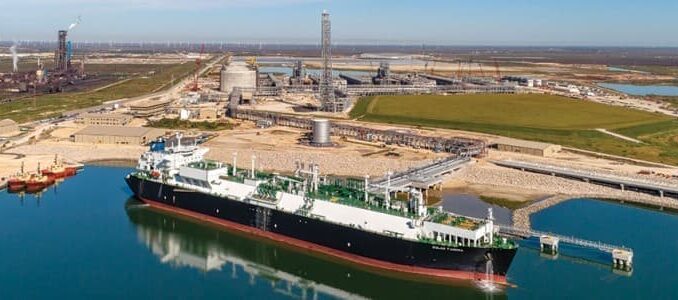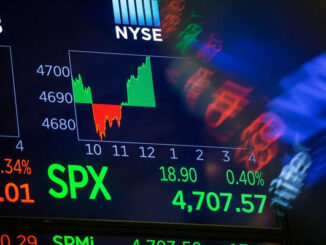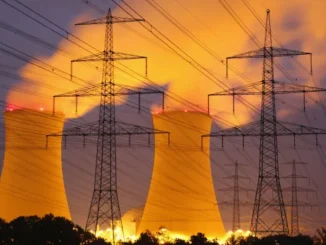
ENB Pub Note: Interesting article from Oilprice.com and Alex Kimani. With the U.S. looking to double its export capacity in the next 5 years, I can see why the CEO of TotalEnergies is saying there may be an oversupply on the market. That being said, you have 11% of natural gas that the EU is still using from Russia, and the Russian LNG they are still buying that will need those U.S. volumes. It is the climate fear mongers and the methane emissions fossil fuel climate activists that the EU needs to fear, as they will try to block all use of LNG and continue down the deindustrialization and fiscal collapse. The EU is about to get very messy. President Trump will need to stand with Qatar to avoid being fined on the imports for their methane and carbon tax rules.
- TotalEnergies CEO Pouyanné: The U.S. is building too many LNG plants.
- The expansion could trigger a long-lasting glut if the projects come online as planned.
- The U.S. LNG deluge could end up being a boon for Europe.
Lately, Wall Street has been warning that oil markets could soon face a surplus, putting more pressure on already depressed oil prices. To wit, Goldman Sachs has predicted that oil markets could be oversupplied by 1.9 million b/d in 2026 amid OPEC+ unwinding production cuts and production in the Americas rising. Wall Street now sees oil prices sinking to the $50s per barrel next year, further compounding a $15/barrel decline in the current year.
And now the experts are telling energy bulls to expect even more misery, with LNG markets headed for a glut in the coming years. TotalEnergies’ (NYSE:TTE) CEO Patrick Pouyanné has warned of a looming LNG supply glut in the United States, shortly after Texas-based NextDecade Corp. (NASDAQ:NEXT) announced it has made a positive final investment decision (FID) on Train 4 at its Rio Grande LNG liquefaction plant with a planned total capacity of 48 million tonnes per annum (mpta).
Pouyanné says the U.S. is building too many LNG plants, which could trigger a long-lasting glut if the projects come online as planned. Pouyanné might have a valid concern. Rio Grande’s Train 4 has LNG production capacity of ~6 mpta, bringing the plant’s total capacity under construction to 24 mpta. Meanwhile, NextDecade has revealed that Train 5 is nearing a positive FID while Trains 6-8 are currently in the development and permitting process. Project costs for Train 4 are expected to total ~$6.7 billion, financed with 40% equity and 60% debt. TotalEnergies holds a 10% stake in Rio Grande LNG.
Interestingly, NextDecade shares tanked 18.6% after the development hit news feeds. This can largely be attributed to the expected share dilution associated with Rio Grande LNG development as well as the large increase in debt load. Currently, NextDecade has a market cap of $2.1 billion and long-term debt of $2.5 billion.
NextDecade shareholders could also share Pouyanné’s oversupply jitters: Previously, we reported that Venture Global (NYSE:VG) commenced LNG production at its Plaquemines LNG plant in December 2024. Production began just 30 months after the final investment decision (FID) was made, making the plant with a 20 mtpa nameplate capacity one of the two fastest greenfield projects to reach first production. Once fully operational, Plaquemines will be among the largest LNG facilities in the world, featuring 36 electrically-driven 0.626 million tonnes per annum (mtpa) liquefaction trains, configured in eighteen blocks.
“Reaching first LNG at Plaquemines at this pace will enable the United States to remain the top exporter of LNG in the world. Between current and planned facilities, Venture Global is prepared to invest $50 billion in energy projects based in the United States which will create jobs, support local economies, strengthen the balance of trade and unleash much-needed US LNG supply to our allies,” remarked Venture Global CEO and Co-Founder, Mike Sabel. Venture Global completed its initial public offering (IPO) on January 24, 2025, raising $1.75 billion by selling 70 million shares at $25 each, which valued the company at approximately $60.5 billion at the time of pricing. However, the shares have been cut by nearly 50% since the IPO.
In January, Cheniere Energy (NYSE:LNG), started producing LNG from the first train of its Corpus Christi Stage 3 Liquefaction Project. The project consists of seven midscale trains, projected to produce over 10 million tonnes per annum (mtpa) of LNG.
That said, Europe will hardly be complaining about America’s LNG deluge.
Over the past couple of years, Europe has gone through stressful summers as it scrambled to refill depleted gas storage ahead of the winter season. Europe has significantly reduced Russian pipeline gas imports, dropping from over 40% in 2021 to about 11% in 2024. This has forced the continent to build new gas supply chains, with Norway and the United States replacing Russian gas. However, the experts are predicting that Europe’s gas woes are likely over thanks to the ongoing LNG boom. Europe’s long-term natural gas outlook is healthy, with global LNG capacity set to increase to 649 bcm in 2026 from 550 billion cubic metres last year, before reaching 890 bcm in 2030. The growth is mainly being driven by the U.S., with gas exports surging 22% Y/Y in the first seven months of 2025 to 83 bcm.
Global LNG supply is set to equal demand in the current year, before the markets flip to a surplus of 50 bcm in 2026 and as much as 200 bcm in 2030.
By Alex Kimani for Oilprice.com
Avoid Paying Taxes in 2025
Crude Oil, LNG, Jet Fuel price quote
ENB Top News
ENB
Energy Dashboard
ENB Podcast
ENB Substack
Related Posts







